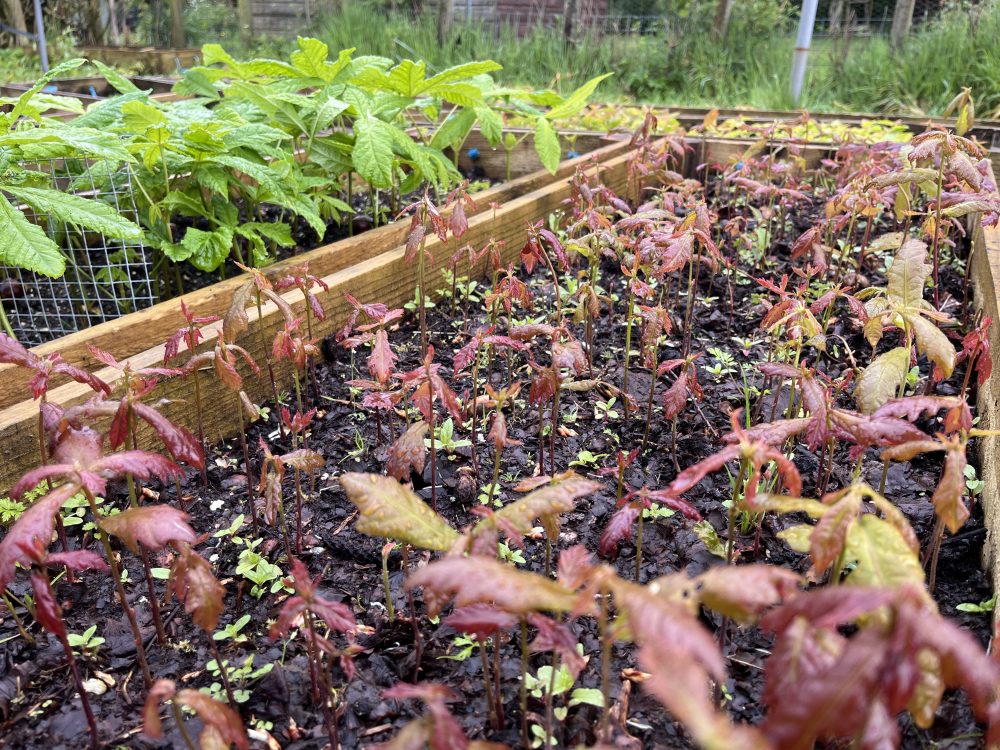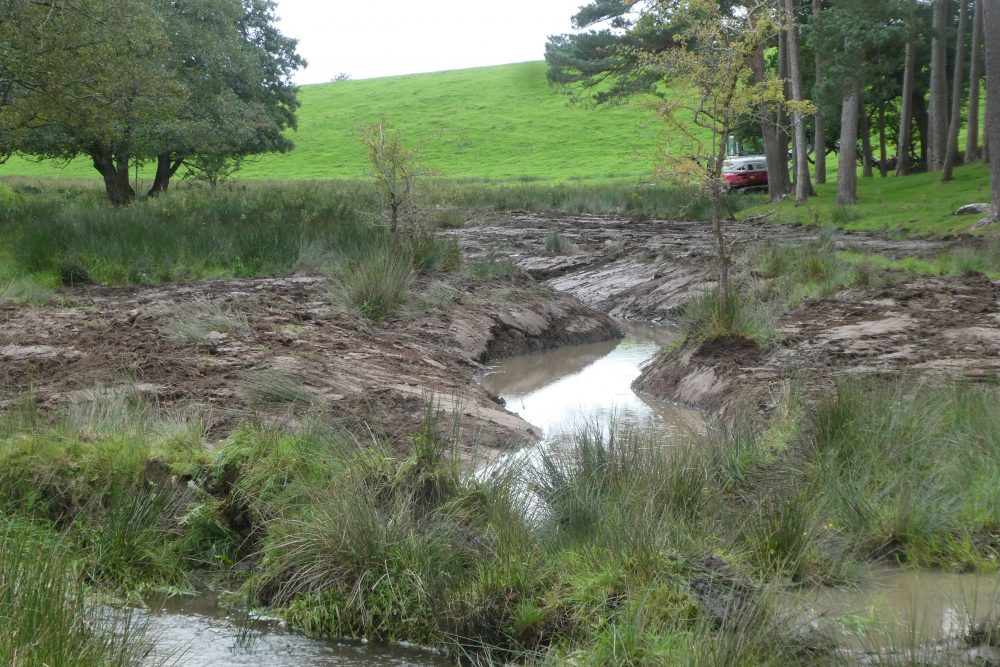
A seed box full of young oak trees almost ready to prick out

This is quite a challenging that we’ve undertaken with this project but I am certain we can improve things considerably even if we can’t resolve everything
In 1859, James Hamilton, the River Doon’s head bailiff wrote to the proprietors of the Doon stating that the Netherton Burn was one of the most important spawning habitats particularly for sea trout. Well a lot has changed since then and barriers, pollution and erosion were features that we felt should be address. With a new progressive and younger owner taking over this farm recently, we felt the time was right to address these complex and related issues. The DSFB were keen to help and this is where they invest the money collected through the angling levy system and funnel it back into the river.

Some of the problems we hope to resolve. Excessive silt washing down from erosion and impacts from livestock poaching and unrestricted access. Water and habitat quality will only improve as a result of our work.

Installing a wetland scrape in marginal ground last autumn. This will benefit amphibians and other species and once naturalised will be surrounded by a mosaic of different grasses, wild flowers and native trees. It retains water even in dry periods and we’ve seen ducks and frogs using it this spring. It is entirely separate to the burn although if the burn bursts its banks in spates, it does eventually top the levels up in the scrape, and slows the flow downstream. There’s an awful lot of common sense behind and benefit to be achieved through modern river management and restoration approaches that have long been lost to river managers. Introducing diversity and recreating natural process can only help and won’t impact farming at all.

Carolyn inspecting a substantial landslide that we hope to stabilse through green engineering, livestock exclusion and tree planting. This is a substantial challenge but one we are all eager and ready to take on. This landslide contributes both spawning sediments and silt to the burn and while gravel and pebbles are a good thing, the fine sediment clogs the spaces between the gravels leaving them unsuitable for fish spawning. Hopefully in time we can reduce the finer sediment reaching the burn allowing the gravels to improve.

Allan and Lee Anne working on the green engineering installation at the toe of the bank while Carolyn scrambled across the slope planting hundreds of willow cuttings. In time their roots should provide some natural reinforcement against erosion. The brash faggots are staked into both bed and the bank and these too should root adding strength to the structure as it become living bank protection. Fine sediment will collect amongst the brash before reaching the stream. Did I mention shade? The benefits of all these willows and the tree planting will provide shade, cooling the water and helping combat some of the greatest pressures we see as a result of climate change.

More or less finished but we may add another terrace higher up the bank if we feel it necessary and beneficial. We will also seed the bare soil with a mix of grass seed and wild flowers and other native ground cover species (we are experimenting with wild raspberry cuttings in our nursery that if successful will be planted here too).

Planting the slope with a healthy mix of native trees and a few half standard pot grown trees in the valley floor. This slope was wooded back in the 19th Century and should soon be again.

Fencing on both banks will be added as soon as we install a solar powered livestock watering system for both fields. This is in hand and should go in later this week. The fencing will be Clippex which is new to us but we are always keen to see how new techniques compare with traditional approaches.
On this site is the largest Alder tree we’ve ever seen and we can only guess as to its age. We’ve taken seeds from it and hope to propagate many new tress to continue with the same genetics. It’s obviously done very well here for I’d guess the last 150+ years and perhaps many more than that.

Carolyn dwarfed by the Alder

Collecting Alder seed

The Blackthorn; another really useful plant found on this land that we collected seed from….and of course used to make some Sloe Gin. Seedlings are coming along well and will be planted out next winter.
We started work on the site late last year and hope to have most things done within the next few weeks although there will be a considerable amount of monitoring and beating up any lost trees over the next year or two. While it is late for planting, we did water all the trees in from a tank of water that we pumped from the burn today and gravity fed down the slope with a hose pipe. We will probably have to repeat this for a few weeks if the weather stays dry.
All in all I think we’ve made great progress so far and I look forward to seeing the results in the next few years as this habitat improves. I’m certain it will be the next few generations that will benefit most from our efforts but that seems to be the way of things as there can never be quick fixes to problems that have been created over the last couple of hundred years.
While the Trust may not always find support from everyone, I do think we are taking great steps to overcome problems and integrate our diverse range of skills and knowledge of fish, rivers, habitat management, wildlife, horticulture and environmental restoration within all our activities. I see the Trust going from strength to strength supporting landowners, farming, SEPA, Scotland’s Marine Directive and of course river management and District Salmon Fishery Boards. Anyone that would like advice or our assistance, please get in touch as I’m sure we will be keen to help.


Great work on the Netherton burn, hopefully trees will help stabilise the banking and put shade on water. Keep up the good work a.r.t. team